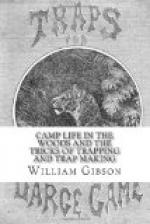In length this formidable animal often exceeds eight feet, and its color varies from yellowish to brownish black, and some specimens are found of a dirty grey color.
The legs are usually darker than the rest of the body, and the face is generally of a lighter tint. The fore limbs of the animal are immensely powerful; and the foot of a full-grown individual is fully eighteen inches long, and armed with claws five inches in length. The grizzly inhabits the Rocky Mountain regions and northward, being found in considerable numbers in the western part of British America. Its hair is thick and coarse, except in the young animal, which possesses a beautiful fur.
All other creatures seem to stand in fear of this formidable beast. Even the huge bison, or buffalo, of the Western Prairies sometimes falls a victim to the grizzly bear, and the very imprint of a bear’s foot upon the soil is a warning which not even a hungry wolf will disregard.
Its food consists of whatever animal it can seize, whether human or otherwise. He also devours green corn, nuts, and fruits of all kinds. In his earlier years he is a good climber, and will ascend a tree with an agility which is surprisingly inconsistent with the unwieldy proportions of his body.
The average weight of a full-grown grizzly is over eight hundred pounds, and the girth around the body is about eight feet.
The Black bear, or Musquaw, which we illustrate is common throughout nearly all the half settled-districts of North America. But as the fur and fat are articles of great commercial value, the hunters and trappers have exercised their craft with such skill and determination that the animals are gradually decreasing in numbers. The total length of the black bear is seldom more than six feet, and its fur is smooth and glossy in appearance. The color of the animal is rightly conveyed by its name, the cheeks only partaking of a reddish fawn color.
It possesses little of that fierceness which characterizes the grizzly, being naturally a very quiet and retiring creature, keeping itself aloof from mankind, and never venturing near his habitations except when excited by the pangs of fierce hunger. When pursued or cornered it becomes a dangerous antagonist; and its furious rage often results in fearful catastrophes to both man and beast. Nothing but a rifle ball in the right spot will [Page 170] check the creature, when wrought up to this pitch of fury, and an additional wound only serves to increase its terrible ferocity. Bear-chasing is an extremely dangerous sport; and there are few bear-hunters in the land, however skilful, but what can show scars from the claws or teeth of some exasperated bruin.




